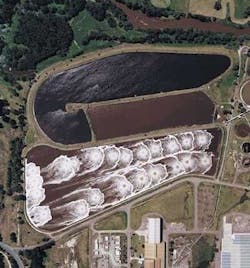CFD program helps improve water velocity in wastewater lagoon
By Dale de Kretser, Brent Matthews, Mike Williams
A computational fluid dynamics (CFD) program developed alternative arrangements of aerators and mixers to increase overall water velocity and minimise solids accumulation in the main treatment lagoon at a wastewater treatment plant, owned by Australian Paper Pty Ltd., Australia.
Aerated lagoons are frequently used to treat diluted wastewater from pulp and paper mills, but one problem with their use is that solids settle and decay. Consequently, costly and disruptive techniques must be employed to remove them. Furthermore, degraded solids that leave the lagoon are difficult to settle in downstream processes so they often reach the receiving environment.
Australian Paper's Maryvale mill is Australia's largest integrated pulp and paper producer. It produces more than 700 tons per day of fine papers and 800 tons per day of packaging grade papers. It also generates 55 million litres a day of wastewater, which is treated through its secondary wastewater treatment system. The main component of this treatment system is an aerated lagoon, which has an average depth of 4.3 m and a capacity of 375 million litres. The pond is approximately 550-m-long and 150-m- to 250-m- wide. It contains a dividing wall in the middle that extends from the inlet side to approximately four-fifths of the pond length. Six 55-kW aerators and sixteen 45-kW aerators mix and aerate the lagoon, providing a total connected power of some 1050 kW and an average mixing intensity of 2.8 W/m3. Mixing energy is not uniform throughout the lagoon, however, and varies from 3.3 W/m3 near the inlet (where the 55 kW aerators are located) to 1.4 W/m3 in other parts.
Australian Paper conducted a study to determine if mixers could be used in place of aerators to increase the degree of mixing and minimise the settlement of solids in the lagoon. The CFD pro-gram FLUENT, developed by Fluent, Inc. of Lebanon, New Hampshire, USA, calculated water velocities throughout the lagoon under different combinations of aerators and mixers.
The first stage of the investigation examined natural flow patterns present in the lagoon, and found a significant degree of short-circuiting occurring, with the majority of the flow proceeding along a dividing wall inside the lagoon. The second stage examined individual flow patterns generated by existing aerators used in the lagoon and one type of mixer, which may be added to the lagoon in the future. Results showed that the aerator provides good surface mixing, but is inefficient at depth, while the mixer promotes good mixing at depth, but is less effective on the surface.
The final stage combined the results of the first two stages to produce overall flow patterns for various parts of the lagoon under the influence of aerators and mixers, with an emphasis on the inlet end of the lagoon. Key findings were:
• The combination of aerators and mixers provided good surface agitation, with the majority of the inlet area having a velocity of 0.05 - 0.1 m/s;
• Mixers provided good mixing in the lower parts of the water column, with the 0.05 - 0.1 m/s velocity band extending to a diameter of 40m;
• Complimentary action of aerators and mixers created a good exchange of water between the surface and the lagoon base.
By solving the flow at every point in the domain, CFD produces a detailed three-dimensional picture of the velocity field, along with results for other relevant variables such as temperature, chemical species, particle concentrations or turbulence. These results can be used to understand a process and to guide changes that will improve operations or optimise processes.
Authors' note
Dale de Kretser of Halliburton KBR Pty Ltd., Brent Matthews of CFD Research Pty Ltd. and Mike Williams of Australian Paper Pty Ltd. wrote this article. For more information, visit the website: http://www.fluent.com.

